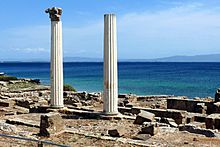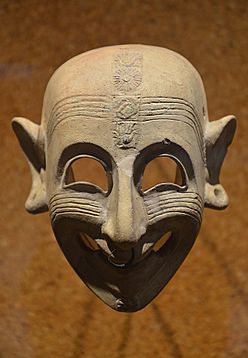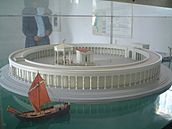Punic people facts for kids
The Punic people, also known as Carthaginians, were an ancient group of people who lived in the Western Mediterranean. They were originally from Tyre in Phoenicia (modern-day Lebanon). They moved to North Africa during the Iron Age, a long time ago.
The word "Punic" is used today to describe these Phoenicians who lived in the western part of the Mediterranean Sea. The biggest Punic city was Ancient Carthage, which is near modern-day Tunis. But there were also about 300 other Punic towns. These towns stretched along the North African coast, from Libya to Morocco. They also lived in parts of Sicily, Sardinia, the Iberian Peninsula (Spain and Portugal), Malta, and Ibiza.
Their language, Punic, was a type of Phoenician. This language came from the Levant (the eastern Mediterranean region). The Punic people kept ties with their homeland. But they also traded a lot with other groups in the west, like Sicilians, Berbers, Greeks, and Iberians. Because of this, they developed their own unique culture.
The Punic people lived in many independent city-states. By the 400s BCE, Carthage became the largest and most powerful city. It took control of Punic areas in Sicily and Sardinia. Later, in the Punic wars (264–146 BCE), the Romans fought against Carthage. Rome eventually destroyed Carthage in 146 BCE. However, the Punic language and culture continued to exist under Roman rule for a long time.
Contents
The Punic People
Who Were the Punics?
The word "Punic" is used by historians today to talk about the western Phoenicians. It comes from the Latin words poenus and punicus. These words were mostly used by the Romans to describe the Carthaginians and other western Phoenicians.
Some ancient coins from Sicily show the word "Phoinix," which was a Greek word for Phoenicians. It's not clear what the Punic people called themselves. Some scholars believe they might have called themselves "Canaanites."
In modern history, "Punic" refers only to the Phoenicians in the western Mediterranean. Sometimes, specific Punic groups are named with a hyphen, like Siculo-Punic (from Sicily) or Sardo-Punic (from Sardinia).
Their Way of Life
Like other Phoenician groups, the Punic people lived in cities. Their economy and culture were closely tied to the sea. They settled across Northwest Africa in areas that are now Algeria, Morocco, Tunisia, and Libya. They also set up colonies in Southern Iberia, Sardinia, Sicily, Ebusus, Malta, and other small islands.
In Sardinia and Sicily, they had strong ties with the local people. Their ships and trade routes went all over the Mediterranean Sea. They even reached Atlantic Iberia, the British Isles, and the Canaries.
The Punic people of Carthage made some clever inventions. They developed a way to make clear, uncolored glass. They also used limestone from lake deposits to make iron purer when they melted it.
Their Beliefs
The Punic religion was a continuation of the Phoenician religion. It was a polytheistic religion, meaning they worshipped many gods, like the ancient Canaanites.
In Carthage, the main gods were Baal Hammon and his partner Tanit. Other gods they worshipped included Eshmun, Melqart, Ashtart, and Shamash. The Carthaginians also started worshipping Greek goddesses like Demeter and Kore in 396 BCE. They also adopted Egyptian gods like Bes, Bastet, Isis, Osiris, and Ra. Different Punic cities had their own special gods. For example, in Punic Sardinia, a local god named Sid (or Sardus Pater to the Romans) was worshipped.
The Carthaginians had both part-time and full-time priests. The full-time priests were called khnm. There were also high priests and other religious helpers like cooks and singers.
Some ancient Greek and Roman writers said that the Carthaginians sacrificed children by burning them. They said this was done for a god called "Cronos" (who was like Baal Hammon). These stories were similar to those in the Hebrew Bible about child sacrifice to Baal and Moloch at a place called Tophet.
When archaeologists found the Tophet of Salammbô in Carthage in 1921, they found urns with the ashes of cremated children. This seemed to support the ancient stories. However, today, historians and archaeologists still discuss how common this practice was. Some think all the remains at the tophet were from sacrifices, while others believe only some were.
Where They Lived
Tunisia
Tunisia was one of the first places the Phoenicians settled in the west. Cities like Utica and Hippo Regius were founded around the late 1100s BCE. Other Phoenician settlements, like Hippo Diarrhytus and Hadrumetum, were built later.
The city of Carthage, near modern Tunis, was founded in the late 800s BCE. Ancient Greek stories say that a group of refugees from Tyre, led by Dido, founded Carthage. In Carthage, people especially worshipped the gods Tanit and Baal Hammon. They also developed a new religious site called the tophet.
Carthage took direct control of the Cap Bon peninsula. They had a sandstone quarry there and built the city of Kerkouane in the early 500s BCE. This region was very fertile, which helped Carthage become self-sufficient. The ruins of Kerkouane have been studied a lot and show us what a Punic city in North Africa looked like.
Punic influence also spread inland to the Libyans. From the early 500s BCE, Punic building styles and pottery appeared in places like Althiburos. There were also conflicts with the Libyans, with several revolts in the 300s BCE. Aristotle wrote that Carthaginians sometimes moved poor citizens to Libyan cities to deal with local problems. These settlements had to pay taxes and provide soldiers but governed themselves. There is some evidence that Punic people and Libyans married each other in the 300s and 200s BCE.
Sardo-Punics (Sardinia)

From the 700s BCE, Phoenicians built cities and strongholds in southern and western Sardinia. These places were often on peninsulas or islands near rivers, making them easy to defend and good natural harbors. Examples include Tharros, Bithia, Sulci, Nora, and Caralis (Cagliari). The northern, eastern, and central parts of the island were still controlled by the native Nuragic civilization. The Nuragic people and Sardo-Punic cities traded and sometimes fought. Many people from both groups married each other, leading to a mix of cultures. The Sardo-Punic cities had a mix of Phoenician and Nuragic people, with the Nuragic people being the majority.
Sardinia was important because it was located in the center of the western Mediterranean. It was between Carthage, Spain, the Rhône river, and Etruria. The Iglesiente area was a key mining region for lead and zinc.
Carthage took control of the island around 510 BCE. They expanded their influence along the western and southern coasts. They strengthened existing Phoenician settlements and founded new ones like Olbia, Cornus, and Neapolis. Tharros was probably the main center. Carthage encouraged growing grain and cereals and did not allow fruit trees. Today, Tharros, Nora, Bithia, and Monte Sirai are important archaeological sites where we can learn about Punic buildings and city planning.
In 238 BCE, after the First Punic War, the Romans took over Sardinia. The Punic culture remained strong for a while under Roman rule. But over time, the local leaders adopted Roman ways, and Latin became the main language.
Ibiza
The island of Ibiza gets its name from a Phoenician word meaning "Dedicated to Bes" (a god). A city, the Sa Caleta Phoenician Settlement, was built there in the mid-600s BCE. The historian Diodorus said it was founded in 654 BCE by the Carthaginians.
Important Events
Early Beginnings
It's not clear exactly when the Phoenicians started settling in North Africa. Ancient writers said it began in the 1100s and 1000s BCE. They told stories about Phoenician settlers meeting famous people from the Trojan War. But archaeological evidence mostly shows that colonies started in the 700s BCE. There isn't much material proof of Phoenician homes before that time.
The Phoenicians started colonies for economic reasons, not to build a huge empire. They didn't have enough people or the desire to create a large overseas empire. So, the colonies were independent city-states. Most were small, with fewer than 1,000 people. But some, like Carthage, grew much larger.
These colonies became very wealthy by controlling the natural resources of the continent. Their wealth grew even more when Phoenician traders moved there. This happened because they were trying to avoid high taxes from foreign powers and problems with trade in their homeland.
Within 100 years, Carthage's population grew to 30,000. Meanwhile, Tyre, the "mother city" of Phoenicia, started to lose its power in the 600s BCE. Phoenicia was eventually conquered by the Neo-Assyrian Empire. By this time, Carthage had become the richest and most powerful of all the Phoenician colonies.
Around this time, a new culture started to form in Carthage. It was a mix of local customs and Phoenician traditions. This also led to a new sense of identity for the Punic people. Tyre's power continued to shrink under the Assyrians and later the Neo-Babylonians. By the 500s BCE, Tyre had very little power left. Its rival city, Sidon, became the leading Phoenician city. But Sidon was also under Persian control. This allowed Carthage to become the main Phoenician political power.
From 650 BCE to 146 BCE
As Phoenicia declined, Carthage became independent from Tyre by 650 BCE. The Carthaginians explored the seas around Africa and other places from their base in Carthage. In the 400s BCE, Hanno the Navigator explored the coasts of modern-day Morocco and other parts of Africa. He wrote down details about the local people. The Carthaginians also sailed west into the Atlantic Ocean. They set up important settlements in places like Lixus and Mogador.
The Carthaginians were trade rivals with the Greeks in Magna Graecia (Greek colonies in Italy and Sicily). They fought several times over the island of Sicily in the Sicilian Wars from 600 to 265 BCE.
Eventually, the Carthaginians also fought Rome in three Punic Wars between 265 and 146 BCE. They lost all three wars. In the First Punic War, they lost control of Sicily. In the Second Punic War, the famous Carthaginian general Hannibal invaded Italy. But he couldn't force the Romans to give up. The Romans later defeated the Carthaginians in Spain and at the Battle of Zama in North Africa in 202 BCE. This ended Carthage's power in the Mediterranean. Finally, in the Third Punic War, Carthage was completely destroyed in 146 BCE. Rome's victory in these wars allowed them to settle in Africa and eventually control the entire Mediterranean Sea.
After the Wars (146 BCE – 700 CE)
The destruction of Carthage did not mean the end of the Punic people. After the wars, the city of Carthage was completely torn down. The land around it became farmland for Roman citizens. However, there were other Punic cities in northwest Africa. Carthage itself was rebuilt later and became important again, though not as powerful as before.
Even though the area became partly Roman, and some people adopted the Roman religion, the Punic language and culture lasted for some time.
People of Punic origin became successful traders, merchants, and even politicians in the Roman Empire. Carthage was rebuilt around 46 BCE by Julius Caesar. Soldiers who retired from the Roman army were given land in the area. Carthage became very successful again, even becoming the second-largest trading city in the Roman Empire, until Constantinople took that spot. The Roman emperor Septimius Severus had Punic ancestors. People said he spoke Latin with a "Punic accent." Under his rule, Carthaginians became part of the Roman elite.
As Christianity spread in the Roman Empire, it was very successful in northwest Africa. Carthage became a Christian city even before Christianity was legal. Saint Augustine, who was born in modern-day Algeria, considered himself Punic. He wrote important thoughts about Punic culture. He noted that Punic Christians called baptism "salvation" and the sacrament of Christ's body "life."
The last signs of a distinct Punic culture probably disappeared during the chaotic time of the fall of the Western Roman Empire. The region's people and culture changed a lot due to events like the Vandals' wars with the Byzantines and the Muslim conquest of North Africa in the 600s CE.
Genetics
Recent studies of ancient DNA show that Punic people from Sardinia, Ibiza, southern Iberia, and Italy had strong genetic links to ancient North African and eastern Mediterranean groups.
For example, a study in 2018 showed that the Punic population of Ibiza had a lot of genetic influence from the Eastern Mediterranean and North Africa, mostly from males.
Another study in 2018 found that people in southern Spain during the Roman period had ancestry from southern Europe, North Africa, and the Levant. This could be due to movement during the Roman Empire or the earlier Phoenician-Punic presence.
Studies from 2020 and 2021 also showed strong genetic connections between Punic people in Sardinia and Italy and populations in North Africa.
However, a 2022 study of ancient individuals from the Carthaginian city of Kerkouane in Tunisia found a mix of people. Some had genetic links to ancient North African farmers, suggesting they were native to the area. Others were similar to people from Sicily and central Italy. Surprisingly, this study did not find many individuals with a lot of Levantine (eastern Mediterranean) ancestry. This might mean that the Phoenician expansion didn't involve huge movements of people. Instead, it might have been more about trade relationships than taking over land. The authors of the study suggest that native North African populations played a big part in the genetic makeup of Kerkouane.
Notable Punic People
- Hannibal: A famous Carthaginian general.
- Hanno the Navigator: A Carthaginian explorer who sailed along the African coast.
- Hamilcar Barca: A Carthaginian general and Hannibal's father.
- Hasdrubal Barca: A Carthaginian admiral and Hannibal's brother.
- Hampsicora: A Sardinian leader who rebelled against the Romans.
- Hasdrubal the Boetharch: The main Carthaginian leader during the Third Punic War.
- Mago: A writer who wrote about farming.
See also
 In Spanish: Púnico para niños
In Spanish: Púnico para niños
- History of Tunisia
- Carthaginian coinage
- Poenulus ("The Puny Punic"): A Roman comedy that shows how Romans saw Carthaginians. It includes some lines in the Punic language.
- Punica: The name for pomegranates, which Romans called mala punica ("the Punic apple").
- Phoenician–Punic literature




